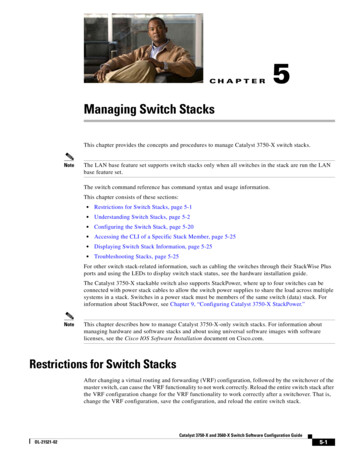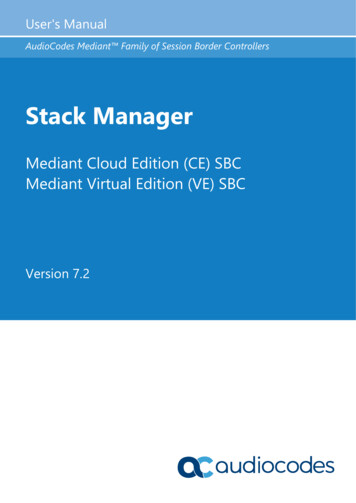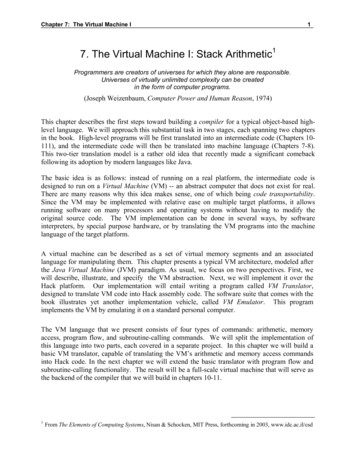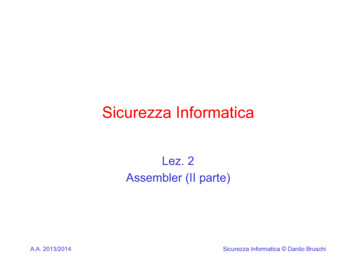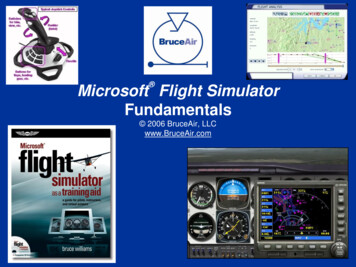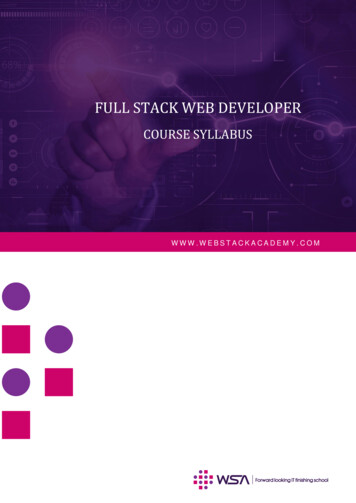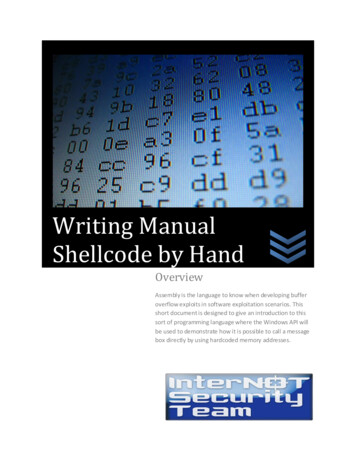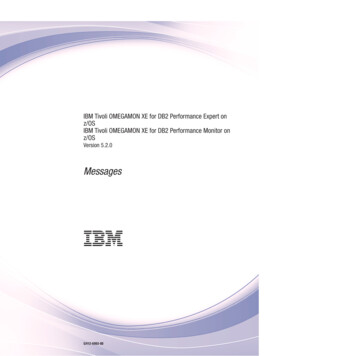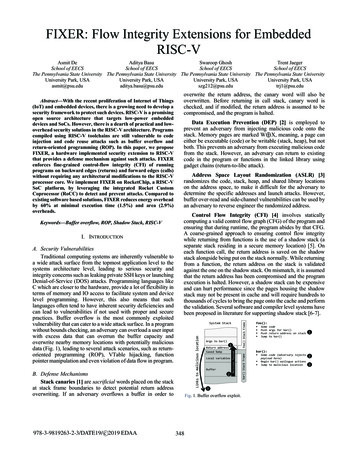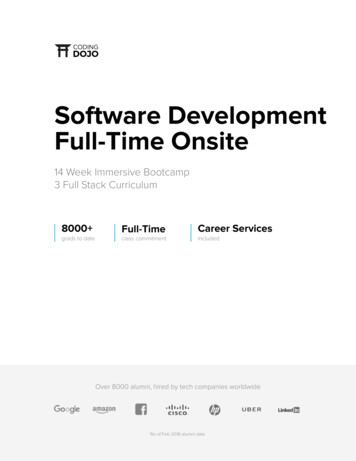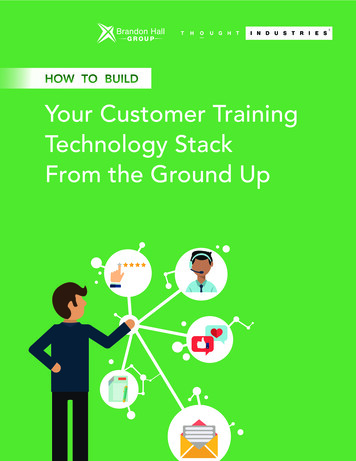
Transcription
HOW TO BUILDYour Customer TrainingTechnology StackFrom the Ground Up
How To Build Your Customer Training Technology StackFrom the Ground UpTable of ContentsThe Rise of Customer Training and its Impact on Business Performance3Top Business Priorities for Organizations3How Training Impacts the Customer Experience4What Drives Customer Experience?4Understanding the Customer Management Lifecycle5Where Customer Training Fits in the Learning Ecosystem6The Role of Frequency in Customer Training7The Anatomy of a Customer Training Technology Stack9Engagement Tools10Best Practices for Choosing Customer Training Technology118 Steps to Building Your Technology Stack12Key Takeaways14About Thought Industries15Authors and Contributors16About Brandon Hall Group17 2018 Brandon Hall Group. Licensed for Distribution by Thought Industries.2
How To Build Your Customer Training Technology StackFrom the Ground UpThe Rise of CustomerTraining and its Impacton Business PerformanceCompanies in every industry are in a stateof disruption. This is especially true forsoftware, technology and subscriptionbased businesses who must now delivervalue at every stage of the customerlifecycle to fend off competition and ensuresustainable recurring revenue.To remain competitive, companies areturning to education to differentiatethemselves and add value to the customerexperience. As a result, they are makinga substantial investment in customertraining.The importance of training in the customerlifecycle cannot be understated. But howdo companies go about the process ofbuilding a customer training program?What resources do you need, and whatis the role of technology? In this guide,you will find the tools necessary to trainyour customers and drive measurablebusiness outcomes.Top Business Prioritiesfor Organizations1Improving customer experience2Gaining market share3Developing new products/services4Driving innovation5Improving sales effectivenessSource: 2019 HCM Outlook StudyFive years ago, customer experience didnot make the Top 5 business priorities inBrandon Hall Group’s annual HCM OutlookStudy. Now it ranks first. Organizations havea better understanding of the impact andimportance of a great customer experienceand are responding accordingly. 2018 Brandon Hall Group. Licensed for Distribution by Thought Industries.3
How To Build Your Customer Training Technology StackFrom the Ground UpHow Training Impacts the Customer ExperienceStrongerrelationshipafter the saleStaying ahead of theinformed consumer“Customer experience” is expressed as asingle thing, but it is really a collection offactors, including: A strong post-sale relationship withthe customer. Access to information that builds on thecustomer’s product knowledge derivedfrom the Internet and social media. Meeting customers’ needs andexpectations to decrease or eliminatereliance on customer support.Delivering compelling learning to customerscan have a big impact on the overall customerLess reliance oncustomer supportexperience. Customers must know how bestto use your product and have success doingso. Customer training helps them do just thatand builds value along the way.Contextual learning teaches customershow to use or apply the product to solveproblems, and is especially effective. Yourcustomer-learning program also can includecertifications, providing recognition andrewards for levels of product expertise. Thiscan drive customer engagement further andcan also provide ancillary revenue if youcharge for the certifications.What Drives Customer Experience?Customer expectationsare changingTraining is becoming astrategic weaponProduct life cycles aremuch shorterCustomer training is a criticalstep in CXDistributed andaugmented workforcesIncreasing pressure of corporatecompliance and security 2018 Brandon Hall Group. Licensed for Distribution by Thought Industries.4
How To Build Your Customer Training Technology StackFrom the Ground UpUnderstanding the Customer ManagementLifecycleTo fully understand the dynamics and impact of customer training, it is important to understandthe customer-management lifecycle and the technology that supports it. Customer-lifecycleproducts are designed to help you manage a specific aspect of the process: collectinginformation about prospects, managing leads, marketing to them, turning them into payingcustomers and keeping them happy. Some companies, such as Salesforce.com, have programsto address each step. Others focus on specific tasks and provide features that overlap withthe others. For example, companies classified as marketing-automation providers may alsoconsider themselves players in the customer-success category. Here’s how to differentiatethe types of products:1Customer-RelationshipManagementTake every lead you can collect and trackthrough the sales cycle from all angles;individual, division, company, industry. Thatprocess includes managing renewals, gaugingthe temperature of your customer andrecording every interaction, which is exactlywhat a CRM is made for. Salesforce.com is thegranddaddy of customer success but there areother CRMs that provide most, if not all, ofthe same features.2Communication AutomationWhile the best learning-management systemsinclude some marketing-automation features,this application is dedicated to the job but alsogained favor among marketing pros in trainingbusinesses. These programs handle leadgeneration and nurturing, email campaigns,lead scoring and data analytics for trackingsuccess and failure. Prime brands includeMarketo, HubSpot and Oracle Eloqua.3Customer SuccessThe newest category of applications helps youstay on top of your customers throughout theentire lifecycle. By doing that, you’ll retain themlonger, discover what attracted them to facilitatefinding more prospects and help them achievetheir goals. As a result, they can be expectedto buy more from you. Or, as the TechnologyServices Industry Association succinctlyexpresses it, the right customer-successtechnology can “reduce churn, lower costs andimprove customer loyalty.“ Prominent examplesinclude GainSight, Natero and Totango.4Customer ServiceOtherwise known as help-desk or supportsystems, these programs provide assistance tothe organizations buying your training and theindividuals using it. The best ones provide acombination of services, including chat, a selfservice knowledge-base, a ticketing system,service level agreement views and reporting tokeep you informed about support metrics. Twoexamples are Zendesk and Kayako. 2018 Brandon Hall Group. Licensed for Distribution by Thought Industries.5
How To Build Your Customer Training Technology StackFrom the Ground UpWhere Customer Training Fits in theLearning EcosystemCustomer training is part of ExtendedEnterprise Learning, as illustrated onthe right. People on both sides of thesupply chain benefit from the trainingyou deliver. This can include yoursuppliers, external sales partnersand most importantly, the customerswho use your products. Brandon HallGroup research shows that 54% oforganizations now extend learningbeyond employees, and of thoseorganizations, about 70% delivertraining on new or existing productsand services, or deliver product orservice information.SalesPurchasingCorporate acturersTHE LEARNING ECOSYSTEMLarger than you thinkPublic CitizensBrand FollowersClients/CustomersSales ChannelsPartnersContractorsEmployees 2018 Brandon Hall Group. Licensed for Distribution by Thought Industries.CustomersTaking a closer look at the LearningEcosystem, you can see that it startswith employees and extends to salespartners, customers and clients,and even “fans” who follow thebrand and seek product knowledge.Extended learning can be a goodrevenue generator, but providing freeproduct training to the general publiccan also create interest and demandamong brand followers and others.The extended-learning ecosystemis tremendously important to retaincustomers by providing a greatexperience, attract new ones and givesales partners the information theyneed to maximize sales opportunities.6
How To Build Your Customer Training Technology StackFrom the Ground UpThe Role of Frequency in Customer TrainingThe extended-learning audience is diverse, and there are also significant differences in thefrequency of training, depending on who consumes it. As these graphics show, organizationsbelieve that customers should be able to access training on a daily basis, much more oftenthan other groups. Surprisingly, 80% of organizations still provide a lot of in-person instructorled training, but that is not sustainable when customers demand any-time access to learning.Organizations seeking to optimize the impact of customer training must fulfill that demandthrough digital technology. But customer training is not the same as training employees. It’simportant to have systems that also track customer demand, deliver meaningful metrics andmeasure ROI.Target Training MonthlyTarget Training WeeklyTarget Training DailyField Technical SupportField Technical SupportCustomer22%Field Customer SupportSales Team12%Customers5%32%12%Sales Team21%Field Customer Support25%12%CustomersSales Team21%10%Field Customer SupportField Technical Support19%7%“Digital transformation closes thegap between what digital customersalready expect and what analogbusinesses actually deliver.”- Greg VerdinoBusiness Futurist and Leading Authorityon Digital Transformation 2018 Brandon Hall Group. Licensed for Distribution by Thought Industries.7
How To Build Your Customer Training Technology StackFrom the Ground UpTHE ROI OF CUSTOMER TRAININGThe key to successful customer trainingis identifying and employing the righttechnology fit. The technology mustdeliver impactful learning, help youattract and retain customers, reducechurn and onboard new customers.Let’s take a closer look.ProductAdoptionGrowth(source: McKinsey)(source: TSIA)trainedcustomers usethe productIf a softwarecompany grows at68%only 20%,it has a87%of ceasing to existwithin a few yearsRenewalRate92% chancetrainedcustomers workindependently(source: TSIA)92%80%trainedcustomersuntrainedCostProfit5 - 255% 25% to 95%(source: Bain & Company Frederick Reichheld)Acquiring a new customer istimes moreexpensivethanRetaining an existing onerenewalrateincrementmore profitif renewal rate is 12% higher,then profit increase by 60-228%The cost of acquiring a new customeris five to 25 times more expensive thanretaining an existing one. Renewingcustomers, especially for softwarecompanies and others operating on aproduct- or service-contract businessmodel, is critical. Industry data showsthat renewal rates for customers thatconsume training are 90%, comparedto 80% for customers who aren’tengaged in training. At first glance, thatmay not sound like a huge impact, butit can mean the difference between athriving company and a struggling –or defunct – one. A 5% renewal rateincrement can lead to 25 to 95% moreprofit. Furthermore, as the graphicshows, investments in training reducescustomer churn, which is killer.HOW CUSTOMER TRAINING IMPROVES THE BOTTOM LINEchurn investment in trainingreduces churnBefore Training((Revenue “Quit” in PeriodRevenue at Beginning of Period20% 2,000,000 20,000,000After Training10% 1,000,000 10,000,000 2018 Brandon Hall Group. Licensed for Distribution by Thought Industries.8
How To Build Your Customer Training Technology StackFrom the Ground UpThe Anatomy of aCustomer TrainingTechnology StackThe key to maximizing customer-training ROIof is having the right types of software to: Oversee the customer lifecycle Manage the learning processes Facilitate and manage communicationbetween you and your customers.The LMS lies at the heart of digital customertraining. First, it serves as the gatewayfor learners—where they head to gettheir assignments, view alerts, receivenotifications, take assessments, receiveevidence of learning, and communicatewith subject matter experts. Second, on theadministrative side, the leading examplesof LMSs, such as the Thought IndustriesCustomer Learning Platform, provide amyriad of features.There are several core features that can: Meet learners where they are to createan engaging learning experience. Allow you to turn your customerlearning, including certification, into aprofit center. Create different types of learning for awide variety of use cases. Enable subject-matter experts unfamiliarwith web-based authoring tools to easilycreate content. Brand your learning effectively. Capture data and report it in compellingways to understand whether yourlearning is delivering desired outcomesand creating the customer experience —and revenue streams — you intend.The different types of software for customersuccess and training can be divided into afew broad usage categories:CustomerLifecycleand SuccessManagementTrainingDelivery andBehaviorChangeCustomerCommunicationCORE FEATURESof a customer-learningtechnology stackNative Authoring& InteroperabilityWeb-based tool to create a highlyengaging learning experiencePowerful CommerceCapabilitiesCustomerSegmentationCloud Hosted& SecureBrandableand ResponsiveIntegrated,SSO & APIsData and ReportingTransaction management,optimized conversion,upsell and discountScalable platform,no maintenanceor developmentOpen and connectedto interact seamlesslywith your tech stack 2018 Brandon Hall Group. Licensed for Distribution by Thought Industries.Manage large volumesof concurrent learningpartnersWhite-label experiencesacross all devices anywhereDeep data, learnerengagement andrevenue analytics9
How To Build Your Customer Training Technology StackFrom the Ground UpEngagement ToolsIn addition to core features, there are other programs that make a business difference for yourcustomer-learning program. They include:?.Meeting SoftwareCommunity Engagement SoftwareThis is also known as virtual classroom,videoconferencing or webinar software, orvirtual instructor-led training (VILT). Someprograms are better suited for pulling peopletogether with video, audio and whiteboardsfor a virtual meetings, while others areintended for slideshow presentations withaudio. Some companies offer both. Examplesinclude Zoom, BlueJeans, Webex, ON24, andGoToMeeting.These products serve as targeted forms ofsocial media. They give people a place toask and answer questions and help eachother. Though answers may come fromcustomers, the company should monitorresponses to ensure they’re correct, or addadditional insights and delete spam or otherinappropriate content. As the informationaggregates, the forum becomes a valuableresource, allowing people to search forinformation without posing a question at all.ChatChat windows, otherwise known asmessaging or instant messaging, arecommon on software home pages, askingif you need help before the purchase. Chatis also a useful mechanism for ongoingcustomer support. It is essential to the stackbecause some people would rather “chat”by text on a web page than pick up thephone and speak to a human. Frequently,these are available as an add-ons to helpdesks — Zendesk Chat or Kayako Messenger— or customer relationship-managementprograms — Salesforce Service Cloud.Blog softwareMost every company has a blog these days,as a forum for sharing news directly withcustomers, promoting events, publicizingnew case studies, and sharing advice andother information. Blog software has becomecontent-management software, serving as atool for creating full websites. WordPress,with open-source and commercial versions,leads the way with most of the globalmarket. Often, the functionality of typicalblog software is included in marketingautomation programs. 2018 Brandon Hall Group. Licensed for Distribution by Thought Industries.10
How To Build Your Customer Training Technology StackFrom the Ground UpYou also may want to include additional programs to complete your customer-training stack.Sometimes, the features of these “one-offs” are also included in one of the platforms we’vealready covered, but that varies by vendor. They include:Customer Engagement ToolsSurvey SoftwareThe ability to run customer-satisfaction surveysis important. SurveyMonkey is a favorite. You canyou quickly set up surveys to learn if people aresatisfied with your customer-support. You can alsoquery new customers about why they haven’t usedtheir trial product or what it would take to getthem to try the latest features you’ve developed.Email MarketingUntil you have full-fledged marketingautomation software in place, you may relyon a dedicated email-marketing servicesuch as MailChimp or Constant Contact.These programs help you stay in touch withtraining prospects and customers.Best Practices for Choosing Customer Training TechnologyNow that you understand the technology that makes up a winning customer-success andtraining operation, it’s time to start building. But first, here are three stacking tips from thepros that will save you time, money and frustration.1All of the programs we’ve listed here generate their own data, but it’sjust data in a silo unless you integrate it and learn from it. An advantageof working with the big names in each category is that they followindustry standards to enable you to connect diverse systems. That canbe done by a connector, application programming interface (API) or adedicated third-party tool, such as Zapier.2While some of the companies referenced here may covet yourcustomer-success and training business, they’re not all best at whatthey do. Map your technology needs to cover the big areas of youroperation, sort out what your existing software already addresses,identify the gaps and run trial versions of applications that could helpclose them. Where you see overlap, go with services that appear tohave staying power, have clear data-privacy options and play well withthe other tools in your stack.3Your customers expect certain things in the training they buy from you:service that’s mobile and works on any device; browser-based so it’salways available; and modular and video-based so they can quicklylearn just what they need. Make sure any service you subscribe to aspart of your tech stack provides the same feature set: mobility, browserbased and outfitted with video training.Interoperabilityis ImportantChooseBest-of-breedRemember:You’re aCustomer Too 2018 Brandon Hall Group. Licensed for Distribution by Thought Industries.11
How To Build Your Customer Training Technology StackFrom the Ground Up8 Steps to Building Your Technology StackNow you understand the technology needed for successful customer training. But howdo you select the right technology to meet your unique needs? Brandon Hall Group has acustomized selection process to help you identify the best customer training technology foryour organization.Build the Business CaseStart by identifying your needs. Make a blue-sky wish-list to address thetypes and frequency of learning you must deliver. Identify — as specificallyas possible — business benefits. Conversely, you need to determinethe impact if you do not conduct customer training or continue to usetechnology not designed for optimum customer learning.Define Your StakeholdersWill L&D own customer training? Or your sales training organization?Beyond ownership, who else has a stake in educating customers?Marketers? Your retail division (if you have one)? Technology must meetthe needs of business stakeholders as well as learners. Make sure youhave a firm understanding of who must benefit internally and involvethem every step in making the technology business case. They can beyour biggest allies — or impediments.Identify RequirementsBased on the level of learning you intend to provide, what functionalitiesare required? You may be at one level of customer training now (or in thenear future), but you must also look to the future. What will you need inthree to five years? Understand where you are headed and ensure yourvision is aligned with business stakeholders and business goals.Create Use CasesWe’ve covered customer training in a general sense, but to ensure youhave the right technology, you must create specific use cases. How willcustomers interact with the training? What are the goals for the training?How will you measure success? All of these things must be thoughtthrough and modeled in use cases. 2018 Brandon Hall Group. Licensed for Distribution by Thought Industries.12
How To Build Your Customer Training Technology StackFrom the Ground UpScripted DemosOnce you build use cases, leverage them to create scripts for vendordemonstrations. Don’t ask a sales rep for a generic demo of functionalitiesand features. Request demos that address your use cases. You mustknow how the system accommodates the specific learning needs of yourcompany and its customers.Use ReferencesOnce your vendor choices are down to a couple of top contenders, contacttheir current clients. Ask questions based on your use cases. Some buyersavoid references because they think vendors would not provide themunless they were going to praise their products. But if you ask specificquestions, references will provide you with insights you might not expect.Even the best user experience includes some hiccups and references willtell you about them — if you ask the right questions.Identify Support LevelsSince no system is perfect, you must know how the technology providersupports their product. Ensure you identify who is responsible for supportduring and after deployment, and the type and level of training you requireto run the system. How much of the training is included at no extra cost?What do you need to pay for? Support can have a big impact on the totalcost of technology ownership, so it’s wise to ask these questions beforemaking a decision.IntegrationFocus on integration with other customer-facing systems. How will yourcustomer-training technology match up with the company’s learningecosystem? If you are going to sell training, ecommerce functionality isrequired, as well. You must really understand how the new system willwork with all other technology your organization relies on. 2018 Brandon Hall Group. Licensed for Distribution by Thought Industries.13
How To Build Your Customer Training Technology StackFrom the Ground UpKey Takeaways Customer training shares some ofthe same goals and modalities withinternal training but has uniqueelements that require a separatestrategy, with technology designedspecifically for customer training. Ensure you understand howcustomer training fits into thecustomer lifecycle, and the types andfrequency of training that are best foryour organization. Focus on finding the right technologyfit for your organization. Donecorrectly, customer training not onlyengages customers and prospectivecustomers, but creates a revenuestream and delivers great ROI thatincludes reducing customer churn. It’s critical to ensure yourtechnology stack includes corefeatures you need to make customertraining successful, but pay attentionto other critical options, such as chat,community software, surveys and emailmarketing to optimize your outcomes. When it’s time to select technology,don’t take shortcuts. Ensure youapproach selection strategicallyand make the business case,leverage internal stakeholders andcreate specific use cases that thetechnology must address. 2018 Brandon Hall Group. Licensed for Distribution by Thought Industries.14
How To Build Your Customer Training Technology StackFrom the Ground UpAbout Thought IndustriesThought Industries was founded with a belief that online learning experiences should be somuch better. Their mission continues today in building a technology for those who are drivingthe future of online learning and need a Customer Learning Platform to help them, build, scaleand deliver training and behavior change that leads to higher engagement, product proficiencyand retention. 2018 Brandon Hall Group. Licensed for Distribution by Thought Industries.15
How To Build Your Customer Training Technology StackFrom the Ground UpAuthors and ContributorsBarry Kelly co-wrote this report. He is CEO and co-founder of Thought Industries. Heis a marketer and digital learning innovator with a proven track record in eLearning,web and mobile product development, customer success, and creative digitalstrategy. His career has been focused on helping organizations leverage the powerof online learning to grow their businesses. He has over 20 years of experience inlearning technology and SaaS product development.Claude Werder (claude.werder@brandonhall.com) wrote this report. He is VicePresident and Principal HCM Analyst for Brandon Hall Group. He runs Brandon HallGroup’s Talent Management Practice, focusing on solving corporate’s challenges indeveloping and retaining talent. He conducts research that focuses on developingnew insights and solutions to help members and clients make talent developmenta competitive business advantage. He also has subject matter expertise inlearning, hiring, and core HR and does advisory work in all of Brandon Hall Group’sHCM practices.Richard Pachter (richard.pachter@brandonhall.com) edited this report. He is theContent Manager at Brandon Hall Group and is responsible for editing all types ofcontent related to research. He has experience as a journalist, copywriter, editor,marketer, blogger and social media marketing manager. He also served as thebusiness books columnist for the Miami Herald for more than a decade.Emma Bui (emma.bui@brandonhall.com) is the Graphic Design Associate at BrandonHall Group. She created the layout and graphics for this report. 2018 Brandon Hall Group. Licensed for Distribution by Thought Industries.16
How To Build Your Customer Training Technology StackFrom the Ground UpAbout Brandon Hall GroupBrandon Hall Group is a HCM research and advisory services firm that provides insightsaround key performance areas, including Learning and Development, Talent Management,Leadership Development, Talent Acquisition, and HR/Workforce Management.With more than 10,000 clients globally and 25 years of delivering world-class researchand advisory services, Brandon Hall Group is focused on developing research that drivesperformance in emerging and large organizations, and provides strategic insights forexecutives and practitioners responsible for growth and business results.Subscribe To Our Interactive Data-Benchmarking Tool: DataNow All the data from our studies is available by subscription to DataNow . DataNow isBrandon Hall Group’s interactive data-benchmarking tool. Organizations use it to makedata-based decisions, find leading practices, benchmark, and more. You can also filter thedata by company size, revenues, and industry segments to give you a fully customized view.Learn more about DataNow .Our ServicesGET HELP TO DRIVE RESULTS FOR YOUR TALENTIn today’s volatile and global business climate, managing talent for high-performance playsan increasingly crucial role in an organization’s growth and future success. Effective talentmanagement is a top priority in organizations everywhere because, while organizationsrecognize the need to obtain and retain people with the very best skills, they continue tostruggle to implement effective strategies to do so. HR and Learning professionals need tobe able to successfully define organizational talents needs and skills, identify talent strengthsand career goals, and align organizational needs to individual needs. Rethink your strategy,validate your assumptions, transform your business, and optimize your time with the use ofreliable data, tools, and guidance.PLANATTRACTDEVELOPPERFORM 2018 Brandon Hall Group. Licensed for Distribution by Thought Industries.RETAINOPTIMIZE17
How To Build Your Customer Training Technology StackFrom the Ground UpOur Services (Continued)GET HELP WITH YOUR HR SERVICES MANAGEMENT & DELIVERYAs described in the employee lifecycle, processes are linked to employee transactional processes(e.g., compensation, benefits, compliance, contingent workforce management, etc.) via workforce planning and analytics. Policies/Process/Procedure Payroll Contingent Workforce Management Expense Management Compliance Benefits & Compensation Time & Labor ManagementGET CONSULTING HELP WITH. Strategy and PlanningGovernance & Business AlignmentExecutive ManagementTeam DevelopmentMeasurement & AnalyticsProgram Design & Deployment Technology Selection, Management & IntegrationOrganizational StructureMeasurement & AnalyticsChange ManagementBudgeting & ForecastingMembership Offers Tailored SupportAt the core of our offerings is a Membership Program that combines research, benchmarkingand unlimited access to data and analysts. The Membership Program offers insights and bestpractices to enable executives and practitioners to make the right decisions about people,processes, and systems, coalesced with analyst advisory services which aim to put the researchinto action in a way that is practical and efficient. Membership also provides you direct accessto our seasoned team of thought leaders dedicated to your success, backed by a rich membercommunity, and proactive support from our client services team.RESEARCH ACCESS & EVENTS ReportsCase Studies, Frameworks & ToolsDataNow & TotalTech Webinars and Research SpotlightsAnnual HCM ConferenceADVISORY SUPPORT Ask the Expert 1 on 1 Consultations Research Briefings BenchmarkingCLIENT SUCCESS PLAN Your Priorities Executive Sponsor Client Associate Monthly MeetingsCLICK HERE TO LEARN MORE 2018 Brandon Hall Group. Licensed for Distribution by Thought Industries.18
businesses. These programs handle lead generation and nurturing, email campaigns, lead scoring and data analytics for tracking success and failure. Prime brands include Marketo, HubSpot and Oracle Eloqua. Customer-Relationship Management Communication Automation 1 2 Customer Success Customer Service 3 4 The newest category of applications helps you
